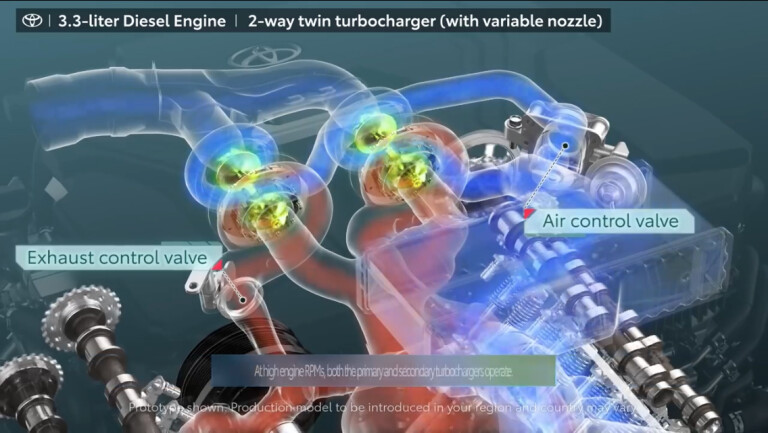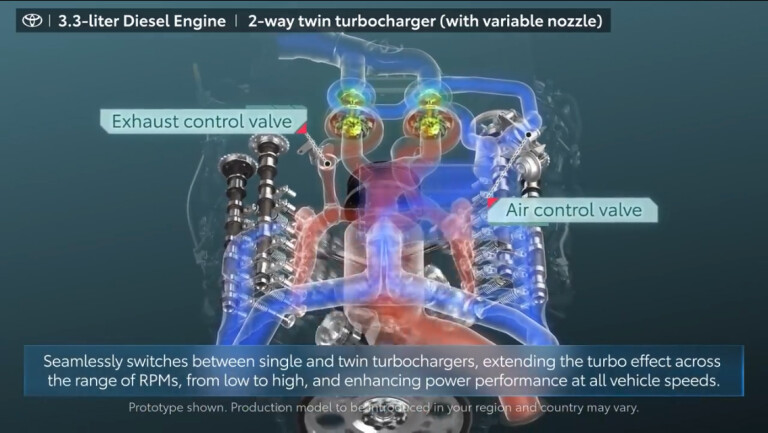
THE Toyota LandCruiser’s outgoing 4.5-litre V8 diesel and incoming 3.3-litre V6 diesel in the 300 Series are both labelled as ‘twin-turbo’ engines, which makes the V6 just seem like a smaller version of the V8. After all, if you just lopped two cylinders off the end of the 4.5-litre V8 you would have a 3.3-litre V6, or thereabouts. But that wasn’t Toyota’s way and, in the case of these two engines, the shared ‘twin-turbo’ descriptor is seriously misleading.
Where the outgoing V8 diesel has a relatively straightforward parallel-turbo system where the two turbos work completely independently from each other, both feeding off and feeding its adjacent bank of cylinders in a wide (90-degree) V-engine. As is conventional practice, the cylinders’ exhaust ports, and consequently the turbos, sit outside of the V. Turbos are best placed as close to the exhaust ports as possible, as this helps in capturing as efficiently and effectively the energy from the engine’s exhaust gas, which is half a turbo’s lot in life. The other half is using that captured energy to drive a compressor that pressurises the air that’s being fed into the engine’s cylinders.

In contrast to the V8’s simple parallel-turbo system, the 3.3-litre V6 uses a complex sequential-parallel system. At lower engine speeds and under lower engine loads (i.e. less throttle) just one turbo operates, feeding off and feeding both cylinder banks. Open up the throttle however, and the second turbo joins in, hence ‘sequential’ in operation, but once up and running, works side-by-side in ‘parallel’ to the primary turbo to help pump more air into the engine. More air to the engine means you can burn more fuel and therefore make more power.
In another significant departure from the V8, the V6’s cylinder heads have been turned around so the exhaust ports face to the centre of the V, with the two turbos sitting side by side within the V in a ‘hot-V’ arrangement. Being a V6, the V angle is most likely 60 degrees to provide the smoothest running. For Toyota, this is its first ever diesel where two turbos are in play in the same inlet/exhaust path.

Complex multi-turbo systems aren’t new for diesels of course and amongst those already in the market, the Toyota system bares most resemblance to Land Rover’s sequential-parallel system as used with its V6s in Discovery and Range Rover/Sport. But where Land Rover used a medium-sized variable-vane primary turbo and a smaller fixed-vane turbo as the secondary, the two turbos in the Toyota system appear to be the same size and both are variable vane. The Land Rover V6s also use the more traditional ‘cold-V’ design.

Both Toyota’s and Land Rover’s sequential-parallel systems are, of course, different again from the Ranger 2.0-litre, Amarok 4-cylinder and Navara D23, all of which are sequential systems where once the second (and main turbo) kicks in, the primary (and smaller turbo) is bypassed.
The lesson here is that the 300 Series V6 is a huge leap forward in sophistication from the V8. It may be 25 per cent smaller in capacity and number of cylinders, but it claims more power and torque. No doubt it will deliver on those promises and, more significantly, it will bring a level of NVH refinement over the gruff-running V8. And to build on its high-tech approach, a direct-shift 10-speed auto is used in place of the V8’s sequential-shift six-speed auto.

COMMENTS